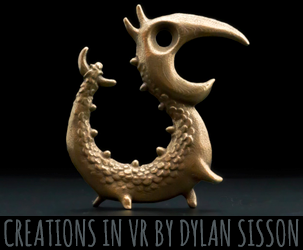


The Fabulous Journey of LUCA
A Re-VIEW by Maria Elena Gutierrez
In Disney and Pixar’s LUCA, a shy young sea monster named Luca emerges from the sea to discover that above the waves there exists a world of unexpected wonders. His guides are Alberto, an adventurous sea monster whose cockiness conceals an essential fragility, and Giulia, a spirited human girl with a fascination for stargazing. Banding together as the ‘Underdogs,’ they compete with the local town bully Ercole to win the coveted Portorosso Cup Race.
Directed by Enrico Casarosa and produced by Andrea Warren, LUCA is a heart-warming celebration of friendship. If we look past the apparent simplicity of its themes, however, we find a complexity as deep as the ocean itself.
Near the beginning of the film, bored with his life as a goatfish herder, a disillusioned Luca blows a bubble in the water and contemplates his own face reflected in the shimmering sphere. Later, Luca studies his surroundings through the bottom of a glass tumbler. When he uses the glass to frame a gramophone at a distance, immediately the object becomes enchanted. In these scenes – throughout the entire film, in fact – we are invited to see the world, and experience the story, through Luca’s eyes.
By viewing reality through the limitations of a lens – a bubble, a tumbler, or the lens of cinema itself – we immediately gain a different perspective. Perhaps even a fantastical one. When Luca first emerges from the water and sees the beautiful green landscape of the Italian Riviera, the blue sky, the warm sunshine, the fluffy clouds, the birds – it is a revelation. The upper world is stunningly beautiful and, in sharing Luca’s eyes, we also share his sense of awe. Through Luca, we rediscover the magic in the everyday.
The film’s emphasis on viewpoint is reminiscent of the work of Japanese filmmaker Hayao Miyazaki. In Studio Ghibli’s My Neighbor Totoro, for example, there is a scene in which we see the young girl Mei looking at the world through a hole in a can. There are many such moments in Luca, when we as an audience are invited to rediscover reality by changing the angle from which we look at things. This is what all art does. It invites us to consider the world from a new perspective. In doing so, we are given an opportunity to do what Picasso strived for his whole life – to see through the eyes of a child. Since Enrico Casarosa is a self-professed Miyazaki disciple, it is no surprise that we find references to Miyazaki’s work everywhere in LUCA – the use of simple forms and compositions, the discovery of wonder in nature, a perennial fascination with flight. Even the name of the town – Portorosso – brings to mind Miyazaki’s film Porco Rosso. However, by bringing his distinctly Italian approach to story, setting and character, Casarosa succeeds in creating his own powerful artistic style.
Luca’s experience of the upper world is presented in glorious detail. The texture of the stone walls is hyper-real. Close-ups of the sea washing on the shore are uncannily ‘realistic.’ Vivid c
But, this is not just beauty for beauty’s sake. Casarosa’s careful use of light and color constantly enhances the mood, and deepens our understanding of the characters. The pivotal scene where Luca betrays Alberto takes place before a stunning sunset, with sea and sky blending into a stunning tapestry. The color
Such moments are the result of confident creative choices, and reveal the complexity hidden inside the film’s deceptive simplicity. By creating a series of powerful emotional resonances, they let us not only share these characters’ experiences, but also look into their souls.
Just as powerful is the sense of place. From the moment when we first spy the lush green coastal slopes of Liguria, there is no doubt we are in Italy. Every detail, every flourish is exactly right, from the shape of Portorosso’s quaint piazza to the way the light shines through the clothes hanging on the washing lines. The Italian vibe pervades the whole film, from locations to language, to the evocative soundtrack featuring popular songs from the 1950s and operatic arias such as Puccini’s O Mio Babbino Caro. The iconic Vespa holds center stage as an object of desire – perhaps even a divine presence – while the photograph jammed between the handlebars of Alberto’s motorcycle is a portrait of Marcello Mastroianni, Italy’s most famous actor of the period.
The Mastroianni photograph is just one of many movie references scattered throughout the film, part of a meta-language used by Casarosa to celebrate cinema in all its forms. The name of the fishing boat in the opening sequence is Gelsomina, which a
This is the Italy remembered by the post-war generation as a land where imagination and innocence still lingered, in defiance of the inexorable advance of modernity. The march of progress is symbolized not only by the Vespa, but also by the motor boats which the humans have begun to favor, and also by the train that carries Luca away at the end of the film.
Adhering to a cinematic trope that evokes classic farewell scenes from a hundred different movies, the train departure scene delivers what is undoubtedly the emotional climax of the film. Here is the moment when Luca fulfils his dream and sets off with Giulia on his way to school, when he says goodbye to his best friend, and Alberto in his turn accepts that he must let Luca go. It is intensely sad, but at the same time uplifting. Before our eyes, we see the two boys coming of age and learning what love truly means. When Luca looks across the ocean and sees a ray of light illuminating the island where he and Alberto had so many adventures, he knows he is leaving his childhood behind. The moment is bittersweet, yet filled with hope, and surely inspired by Enrico Casarosa’s own youthful journey across the ocean from Italy to study animation in the United States.
Anyone who has ever left someone or something behind to follow their dreams will empathize with Luca as he boards that train. Luca’s own journey is driven by a thirst for knowledge, and an insatiable curiosity about the cosmos – an inner fire whose flames are fanned by the equally enthusiastic Giulia. Like every Italian child before her, Giulia has no doubt learned the lines from Canto 26 of Dante’s Inferno, spoken by Ulysses as he urges his crew to voyage with him into the unknown: “You were not made to live for brutish ignorance, but to pursue virtue and knowledge. Consider your humanity.” The lines might have been written for Luca himself.
Earlier in the film, we see Luca’s secret desires encapsulated in a literal dream, one of several fantasy sequences that employ an exaggerated visual language to catapult the audience into the boy’s imagination. In this dream, a Leonardo da Vinci flying machine carries Luca and Giulia to Rome, where they fly over the Coliseum. Art, science and history collide in this scholarly flight of fancy, and literature makes its appearance, too, when they spot the wooden boy Pinocchio strolling below them. References to Carlo Collodi’s Pinocchio are pervasive in this film.
Giulia has a small Pinocchio sculpture in her bedroom. The Pinocchio-inspired song Il Gatto e la Volpe by Edoardo Bennato plays on the soundtrack during a montage of the two boys cementing their friendship on the island. When Luca takes his first steps on dry land, his clumsiness evokes the awkward stumblings of the stringless puppet in Disney’s 1940 animated feature. When Luca dreams of going to school, is he not really dreaming about becoming a real boy, just like Pinocchio? Surely he is.
In leaving behind his underwater home, Luca ultimately comes full circle, just like any hero following the classic journey outlined by Joseph Campbell. As the train leaves the station, the rain causes both Luca and Alberto to transform from human back into their original sea monster forms. We have seen this metamorphosis many times already in the film– a subtle and expressive feat of technical animation, by the way – but only now do we recognizethat the transformation does not represent the otherness that so many of the film’s characters fear. Rather, it represents unity. Luca is neither human nor sea monster. He is both. He is, simply, Luca.
And so, in that moment, we are returned to the beginning of the film, by way of a framing device we did not even notice was there, but which is evident now as we recall the opening shots of LUCA. In a clear visual nod to Casarosa’s short film La Luna, these show the fishing boat Ge
through moonlit waves. All is dark and mysterious, with nothing to differentiate between sky and sea. The surroundings are primordial. We are in the realm of fable.
The images of the train steaming through the Italian Riviera may appear more sophisticated, but they are no less fabulous, no less steeped in myth. Together, these two scenes serve as beautifully balanced bookends to the story of LUCA. They teach us that water, earth and air are one, and that it does not matter if we live on land or in the sea. We are all just individuals on a journey, in pursuit of our dreams.
Dr. Maria Elena Gutierrez is the CEO and executive director of VIEW Conference, Italy’s premiere annual digital media conference. She holds a Ph.D. from Stanford University and a BA from the University of California Santa Cruz. VIEW Conference is committed to bringing a diversity of voices to the forefront in animation, visual effects, and games. For more information about the VIEW Conference 2021 program of events, visit the official website: https://www.































